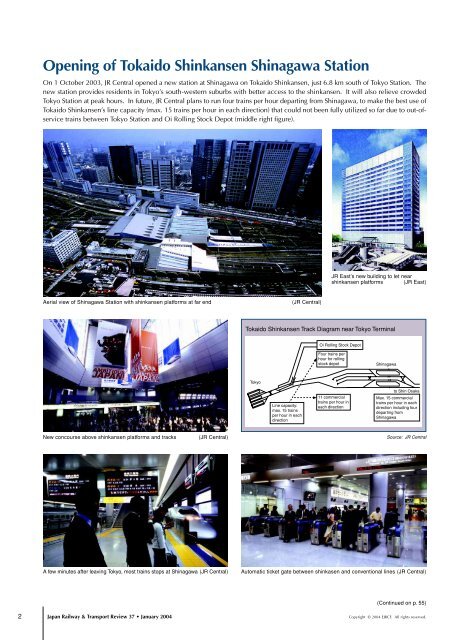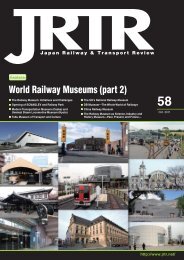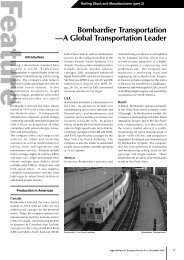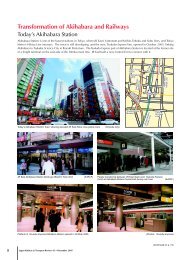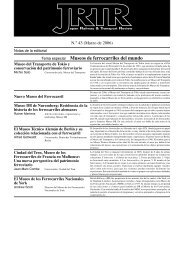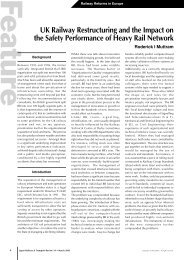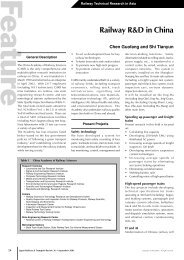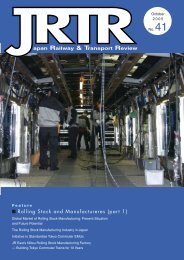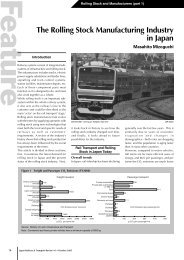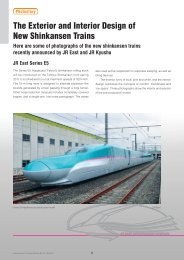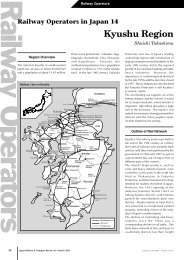Opening of Tokaido Shinkansen Shinagawa Station - JRTR.net
Opening of Tokaido Shinkansen Shinagawa Station - JRTR.net
Opening of Tokaido Shinkansen Shinagawa Station - JRTR.net
Create successful ePaper yourself
Turn your PDF publications into a flip-book with our unique Google optimized e-Paper software.
<strong>Opening</strong> <strong>of</strong> <strong>Tokaido</strong> <strong>Shinkansen</strong> <strong>Shinagawa</strong> <strong>Station</strong><br />
On 1 October 2003, JR Central opened a new station at <strong>Shinagawa</strong> on <strong>Tokaido</strong> <strong>Shinkansen</strong>, just 6.8 km south <strong>of</strong> Tokyo <strong>Station</strong>. The<br />
new station provides residents in Tokyo’s south-western suburbs with better access to the shinkansen. It will also relieve crowded<br />
Tokyo <strong>Station</strong> at peak hours. In future, JR Central plans to run four trains per hour departing from <strong>Shinagawa</strong>, to make the best use <strong>of</strong><br />
<strong>Tokaido</strong> <strong>Shinkansen</strong>’s line capacity (max. 15 trains per hour in each direction) that could not been fully utilized so far due to out-<strong>of</strong>service<br />
trains between Tokyo <strong>Station</strong> and Oi Rolling Stock Depot (middle right figure).<br />
JR East’s new building to let near<br />
shinkansen platforms (JR East)<br />
Aerial view <strong>of</strong> <strong>Shinagawa</strong> <strong>Station</strong> with shinkansen platforms at far end<br />
(JR Central)<br />
<strong>Tokaido</strong> <strong>Shinkansen</strong> Track Diagram near Tokyo Terminal<br />
Oi Rolling Stock Depot<br />
Four trains per<br />
hour for rolling<br />
stock depot<br />
<strong>Shinagawa</strong><br />
Tokyo<br />
Line capacity:<br />
max. 15 trains<br />
per hour in each<br />
direction<br />
11 commercial<br />
trains per hour in<br />
each direction<br />
to Shin Osaka<br />
Max. 15 commercial<br />
trains per hour in each<br />
direction including four<br />
departing from<br />
<strong>Shinagawa</strong><br />
New concourse above shinkansen platforms and tracks<br />
(JR Central)<br />
Source: JR Central<br />
A few minutes after leaving Tokyo, most trains stops at <strong>Shinagawa</strong> (JR Central)<br />
Automatic ticket gate between shinkasen and conventional lines (JR Central)<br />
(Continued on p. 55)<br />
2 Japan Railway & Transport Review 37 • January 2004 Copyright © 2004 EJRCF. All rights reserved.
Renovated Subway Museum in Tokyo<br />
On 1 June 2003, the renovated Subway<br />
Museum was opened in Tokyo. Located<br />
under the elevated Tozai subway line near<br />
Kasai <strong>Station</strong>, east Tokyo, the museum was<br />
first opened in 1986. The museum is<br />
proud <strong>of</strong> two original metro cars; No.<br />
1001 <strong>of</strong> Ginza Line, Japan’s first<br />
underground railcar built in 1927, and<br />
No. 301 <strong>of</strong> Marunouchi Line, the first<br />
postwar car built in 1954. A modified<br />
version <strong>of</strong> the latter is called Type 500, <strong>of</strong><br />
which some units were sent to Argentine<br />
after retirement and are still running on<br />
Buenos Aires metro lines.<br />
No. 301 <strong>of</strong> Marunouchi Line gave fresh impression to passengers in the mid-1950s<br />
(T. Suga)<br />
Interior <strong>of</strong> No. 1001 with life-size dummies in<br />
costume <strong>of</strong> 1920s<br />
(T. Suga)<br />
No. 1001 <strong>of</strong> Ginza Line with yellow body carries an image <strong>of</strong> Berlin U-Bahn<br />
(T. Suga)<br />
Driving simulator is the most popular attraction (T. Suga) Three concrete tunnel segments with various trackside equipment (F. Narita)<br />
Copyright © 2004 EJRCF. All rights reserved. Japan Railway & Transport Review 37 • January 2004 55 3


